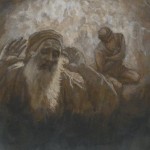An evil “dark and false Church” works to destroy the true Church from within, according to Pat Archbold at The National Catholic Register. Admitting his hysterics might come across as hyperbolic and overly dramatic, he warns us of “rebellious and disobedient children” who will not leave the Church because “the real work of destruction is inside and they have spent a century climbing to the positions where they can complete their work.” Unless we “relentlessly beg our good God to rescue us from this ‘dark and false Church,'” there will be “a terrible price to pay. Our Lady will not be able to restrain the flaming sword of our destruction.”
Archbold fears the Synod on the Family may be the beginning of the end, but sees the origin of the crisis beginning earlier:
This work of destruction is a century in the making. There are those who wish to blame Vatican II for all the evil in the Church, but that is naïve. The ambiguities and novelties of some documents of Vatican II were placed there and exploited by those in this “dark and false church” prior to Vatican II. The cracks in Vatican II and all that followed are merely symptoms of the growth “dark and false church.”
Actually, these “ambiguities and novelties” go back further than whenever this “dark and false Church” was supposedly born. Sacred Scripture is a treasure trove of them. God revealed using ambiguous speech knowing well that sincere people trying their best to live by his Word would arrive at more conflicting interpretations than you can count. If you think Vatican documents use ambiguous and inconsistent language, you should check out the Bible. It’s composed from multiple perspectives and in multiple genres including historical narratives, apocalyptic stories, myths, psalms, epistles, and prophecies. Enigmatic metaphors and obscure vocabulary galore! Some of its statements are clear. Others not so much. Even the Commandments need a good deal of unpacking to get to all their possible meanings. The ambiguity of Revelation isn’t a problem that the Church needs to solve, but a mystery the Church is tasked to help us explore and live.
The integrity of our faith includes ambiguity. Of course it does. What would you expect given that God revealed an infinite mystery through finite human language? How could it be otherwise when human creativity contributes to the formulation, interpretation, and application of doctrine? The realities to which doctrines refer won’t change. They are what they are. But our understanding of those realities can and certainly does change. Interpretation is always contextual and context is fluid.
As for the Synod, the Church has room to develop its understanding of marriage. The Catholic idea of marriage (and sexuality) isn’t some Platonic Form that dropped from heaven and that we understand in its pure essence. Our understanding of the nature and obligations of marriage is wedded to human understanding more broadly. It presupposes theological, philosophical, historical, psychological, sociological and experience-based premises that are open to revision. Of course, the Church also interprets reality within the framework of Revelation (itself interpreted) and her Tradition (also interpreted), so it’s not like the Church has the leeway to say anything whatsoever about marriage or anything else. The relativism of her teaching is not absolute.
Then again, I may say all this as an agent of the dark and false Church. You never know.
Kyle Cupp is the author of Living by Faith, Dwelling in Doubt. Follow him on Facebook and Twitter.












